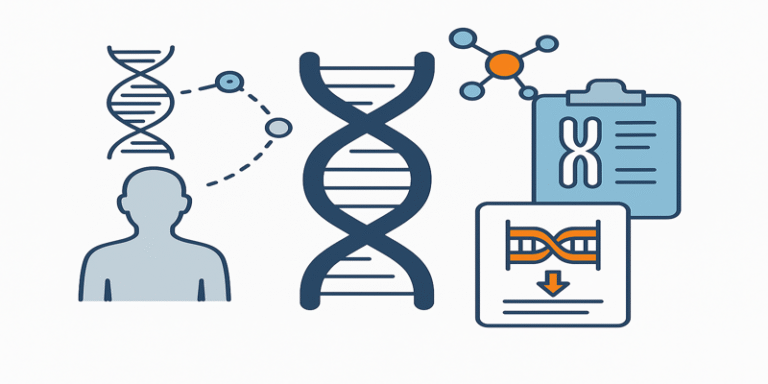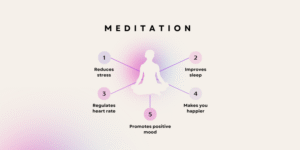Genetics is the branch of biological science that studies heredity and the molecular mechanisms by which traits, characteristics, and diseases are transmitted from one generation to the next. It focuses on the structure and function of DNA, the genetic code that acts as the blueprint for life, and how variations in this code influence human health.
In the field of medical and health sciences, genetics plays a central role in understanding disease mechanisms, improving diagnosis, guiding treatment, and advancing prevention strategies. From identifying inherited disorders like cystic fibrosis to developing personalised medicine, genetics has transformed healthcare in both clinical and research settings (Strachan and Read, 2018).
1.0 Foundations of Human Genetics
The science of genetics in humans builds upon the work of Gregor Mendel, whose 19th-century experiments with pea plants revealed predictable patterns of inheritance. His principles, known as Mendelian genetics, explain how single-gene traits follow defined rules of transmission. While these rules apply to many inherited disorders, modern human genetics recognises that most traits and diseases are influenced by multiple genes (polygenic inheritance) and by environmental factors (Visscher et al., 2017).
In medicine, understanding Mendelian inheritance is vital for:
- Predicting recurrence risks in families.
- Genetic counselling for prospective parents.
- Identifying carriers of disease-causing mutations.
2.0 DNA: The Blueprint of Life
Deoxyribonucleic acid (DNA) is the molecule that stores genetic information in the form of sequences of nucleotides. The human genome contains approximately 20,000–25,000 genes, each coding for a protein or functional RNA molecule (Alberts et al., 2015).
Key molecular processes include:
- Replication – copying DNA during cell division.
- Transcription – producing RNA from DNA templates.
- Translation – synthesising proteins from RNA.
These processes are fundamental to normal growth, development, and physiological function. Mutations—changes in the DNA sequence—can disrupt these processes, leading to disease.
3.0 Key Areas of Medical Genetics
3.1 Mendelian Genetics
Focuses on single-gene disorders that follow simple inheritance patterns, such as:
- Autosomal recessive: cystic fibrosis, sickle cell anaemia.
- Autosomal dominant: Huntington’s disease, Marfan syndrome.
- X-linked: haemophilia, Duchenne muscular dystrophy.
Recognising these patterns allows clinicians to assess risk and offer appropriate screening.
3.2 Molecular Genetics
Examines gene structure, expression, and regulation at a molecular level. It is essential for identifying the pathogenic mutations responsible for disease and for developing targeted therapies. For instance, BRCA1 and BRCA2 gene testing can identify women at increased risk for breast and ovarian cancers (King et al., 2003).
3.3 Genomic Medicine
Uses genome-wide data to tailor healthcare to the individual. Pharmacogenomics—the study of how genetic variation affects drug metabolism—is now used to optimise treatment for conditions like depression, cancer, and cardiovascular disease (Roden et al., 2019).
4.0 Clinical Applications in Human Health
4.1 Diagnosis of Genetic Disorders
Genetic testing enables the detection of inherited diseases at any life stage:
- Prenatal testing can detect conditions like Down syndrome through amniocentesis or non-invasive prenatal testing (NIPT).
- Newborn screening identifies treatable metabolic conditions early, improving outcomes.
- Diagnostic testing in symptomatic individuals confirms clinical suspicions.
4.2 Personalised Medicine
By integrating genetic data into clinical decision-making, healthcare providers can:
- Select the most effective drug and dosage.
- Avoid adverse drug reactions.
- Design prevention plans based on genetic risk profiles.
4.3 Cancer Genetics
Many cancers are driven by specific genetic mutations. Identifying these mutations allows for targeted treatments, such as HER2 inhibitors in breast cancer or EGFR inhibitors in lung cancer.
4.4 Infectious Disease
Genetics informs public health strategies by tracing pathogen genomes, identifying resistance mutations, and aiding vaccine development—evident during the COVID-19 pandemic.
5.0 Genetic Variation and Health
Genetic variation among humans can be:
- Single nucleotide polymorphisms (SNPs) – the most common type, often used in genetic association studies.
- Copy number variations (CNVs) – larger changes affecting multiple genes.
- Structural variations – including inversions, deletions, and translocations.
Such variations influence disease susceptibility, response to treatment, and physical traits. Understanding them is critical for predicting health outcomes.
6.0 Technologies Driving Medical Genetics
6.1 DNA Sequencing
Next-generation sequencing (NGS) allows rapid and cost-effective whole-genome or exome sequencing, facilitating precision diagnostics.
6.2 Polymerase Chain Reaction (PCR)
Widely used to amplify DNA, PCR is essential for diagnostic testing, pathogen detection, and genetic research.
6.3 CRISPR-Cas9 Genome Editing
A revolutionary tool enabling precise genetic modifications. Potential applications include correcting disease-causing mutations in conditions like sickle cell disease, though ethical and safety considerations remain.
7.0 Ethical, Legal, and Social Considerations
The integration of genetics into healthcare raises significant issues:
- Genetic privacy – ensuring secure storage and access to genetic data.
- Informed consent – particularly for predictive testing.
- Equity of access – preventing disparities in access to advanced genetic services.
- Gene editing ethics – especially concerning germline modifications that can be inherited.
International bodies, such as the Nuffield Council on Bioethics (2016), stress the need for responsible regulation and public dialogue.
8.0 Future Directions in Human Genetics
The future of genetics in healthcare is likely to be shaped by:
- Routine whole-genome sequencing in primary care.
- Integration with artificial intelligence to enhance diagnosis.
- Gene therapy for a growing number of genetic diseases.
- Population genomics for tracking disease patterns and informing public health policies.
These developments promise earlier interventions, better treatments, and improved health outcomes.
From its origins in Mendelian inheritance to the current era of precision medicine, genetics has revolutionised the medical and health sciences. It has provided tools to diagnose inherited disorders, tailor treatments to individuals, and understand the biological basis of disease.
As Strachan and Read (2018) emphasise, the future of medicine will increasingly depend on genetic knowledge—offering opportunities to improve human health while also demanding ethical oversight and equitable access. The challenge for the coming decades is to ensure that these advances benefit all people, not just a privileged few.
References
Alberts, B., Johnson, A., Lewis, J., Morgan, D., Raff, M., Roberts, K. and Walter, P., 2015. Molecular Biology of the Cell. 6th ed. New York: Garland Science.
King, M.C., Marks, J.H. and Mandell, J.B., 2003. Breast and ovarian cancer risks due to inherited mutations in BRCA1 and BRCA2. Science, 302(5645), pp.643–646.
Nuffield Council on Bioethics, 2016. Genome editing and human reproduction: social and ethical issues. [online] Available at: https://www.nuffieldbioethics.org/publications/genome-editing-and-human-reproduction [Accessed 9 Aug. 2025].
Roden, D.M., McLeod, H.L., Relling, M.V., Williams, M.S., Mensah, G.A., Peterson, J.F. and Van Driest, S.L., 2019. Pharmacogenomics. The Lancet, 394(10197), pp.521–532.
Strachan, T. and Read, A., 2018. Human Molecular Genetics. 5th ed. New York: Garland Science.
Visscher, P.M., Wray, N.R., Zhang, Q., Sklar, P., McCarthy, M.I., Brown, M.A. and Yang, J., 2017. 10 years of GWAS discovery: Biology, function, and translation. American Journal of Human Genetics, 101(1), pp.5–22.









